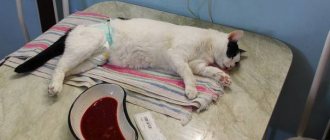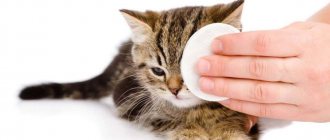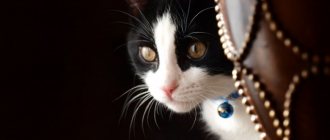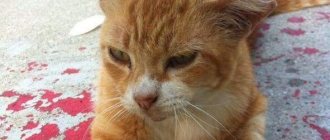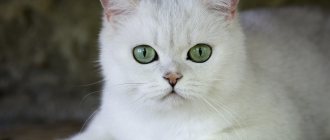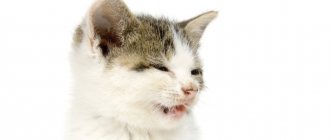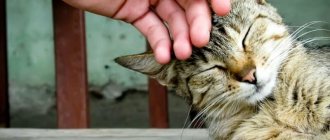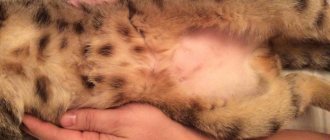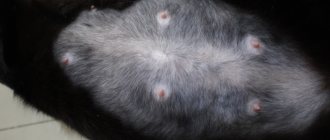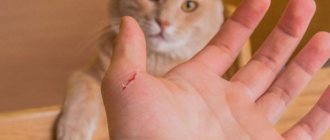Why can a cat walk in circles?
Every owner needs to understand that if a cat starts walking in circles, then this is a fairly serious symptom and should under no circumstances be ignored. The reasons for this behavior may vary. The most harmless of them is worms. In this case, the animal demonstrates restless behavior at night, can take multiple walks along the same route, but its coordination is not impaired and during the day it behaves more calmly. In this case, a regular anthelmintic purchased at a veterinary pharmacy will help.
But it happens that walking in circles is accompanied by other, more serious symptoms, such as:
- impaired coordination;
- loss of appetite;
- twitching of limbs;
- legs give way;
- tongue hanging out.
All these unpleasant signs indicate that the animal’s nervous system has been damaged. Most often, older animals suffer from such problems, but occasionally symptoms can also be observed in young ones. The cat walks clockwise or counterclockwise, sometimes it can bump into walls, or fall to the floor and kick its feet.
It is possible to identify the main possible causes of such disorders on the part of the central nervous system, these are::
- a brain tumor;
- stroke;
- toxoplasmosis;
- otitis;
- high blood pressure.
The latter option most often occurs in cats with kidney failure and can lead to stroke, so cats with chronic kidney disease should undergo periodic veterinary monitoring and receive appropriate treatment. If kidney problems have been going on for more than a year, such an animal should be treated with increased attention. If the case is advanced, the cat walks in circles and its condition gets worse, the situation can end in tears.
Associated symptoms
Walking in circles in cats is accompanied by a number of other signs that may indicate a possible disease. Associated symptoms include the following:
- poor appetite or complete refusal to eat;
- lack of coordination in space;
- sticking out the tongue for no reason;
- wobbly paws, inability to stand straight on your feet;
- twitching of limbs.
All of the above signs also indicate a disorder in the nervous system. Most often, such signs are observed in old animals, as well as in severe diseases of the brain, spinal cord, liver and kidneys. Among the possible causes, veterinarians often identify a stroke condition. In any case, if your pet is found to be unwell, you should quickly begin treatment for the disease in order to avoid the death of your furry friend.
How to help if your cat is walking in circles
In this case, it is more important than ever to correctly and timely determine the cause of the problem and make the correct diagnosis . Self-medication is unacceptable here. As mentioned above, such symptoms are only rarely evidence of non-serious diseases, such as helminthiasis. In all other cases, if a cat walks in a circle, the pet’s health is in danger, which means that it needs to be taken to a veterinary clinic as soon as possible or a veterinarian can be called to your home. Such symptoms should not be ignored under any circumstances.
It is necessary to describe the cat's condition in detail to the veterinarian, as well as describe the animal's lifestyle, diet, possible injuries or other reasons that could lead to behavioral disorders.
It is especially worth paying attention to such problems as previous otitis media, physical injuries, blows, bruises, falls from great heights and other situations in which the cat could have been injured.
Then, based on the results of the examination, a diagnosis is made and treatment and medication are prescribed for the cat. For tests, you may need to give urine and blood (detailed biochemistry and OKA), do an ultrasound examination, or an MRI. Sometimes the animal is given a drip or given injections. During this period, the cat’s appetite may be severely impaired, it may refuse to eat, so its body must be helped to remain in a viable state, for this purpose the administration of saline solutions is prescribed.
- a brain tumor;
- stroke;
- toxoplasmosis;
- otitis;
- high blood pressure.
Treatment of SCD
Treatment depends on the disease, this is understandable. What to do with “feline Alzheimer”?
Alas, while dogs diagnosed with SCD have been treated with medication (L-deprenyl is a drug used for people with Parkinson's disease), and then only in the USA and Canada, there are no approved medications for cats (some human remedies sometimes give positive results, but everything is still at the experimental stage).
Changing your diet may help. Ideally, food for older cats should contain antioxidants (a set of vitamins C, E and beta-carotene), essential fatty acids, as well as chondroprotectors (methionine, glucosamine, chondroitin) and the amino acids L-carnitine and lysine.
Someday!... In the meantime, we can offer our wards all possible treatment, comfort, peace, good food, and, most importantly, our love and care. Let our pets age gracefully!
The nervous system is the most important for the body, as it controls absolutely all processes occurring in it. With its lesions, a wide variety of effects can be observed, often combined with the term ataxia. This pathology may well occur in cats.
Without going into details, this is the name for a set of symptoms that imply problems with coordination of movements and body position in space. There are three types of this pathology:
- Cerebellar
ataxia in cats is caused by damage to the cerebellum.
- Accordingly, vestibular
occurs in cases where something is very wrong with the vestibular apparatus located in the inner ear.
- Sensitive
. In some ways it is similar to the cerebellar, only in this case important nerve cords are damaged.
There are different causes of ataxia in cats. Most often, the development of the disease is due to:
- Poisoning with various poisons.
- Hereditary diseases accompanied by degenerative phenomena in the nervous tissue.
- Injuries that occur especially often in March, when loving cats fall from balconies.
- Lack of vitamin B1. This is generally typical for cats: many owners “pamper” them with fresh river fish, which contains the enzyme thiaminase. It destroys thiamine, that is, B1, resulting in ataxia. This is especially noticeable in kittens.
- If the cat is “hooked” on some plants. For example, a large dose of catnip can send a cat into “nirvana” for several minutes. At this time, the pet looks like an inveterate drunkard.
- Traumatic brain injury.
- Tumor.
- Infection. In particular, the feline is very dangerous.
- or cerebral edema.
Why does the cat walk in circles
Home Consultations
We have a private house and the cat has lived mainly on the street since he was about one year old, now he is about 4.5 years old. Noble breed. The problems started mostly last summer. At first, the fistula in the neck, probably received in a fight, did not go away for a long time. Gave a complication in the ear, which was expressed by purulent discharge and loss of coordination. They prescribed antibiotic injections, peroxide rinses and ear drops. It seems like they have been cured. About two weeks ago I had problems with my eyes - the third eyelid almost didn’t open, but it went away on its own within three days. And three or four days ago the main problems began: it seems that the cat has lost not only coordination, but also orientation, walks in small circles, counterclockwise, legs give way, and falls on its side. At the same time, he meows loudly, which was not the case before. Also meows when trying to pick him up. My appetite has decreased a little. When he goes to the bowl and tries to eat, it doesn’t turn out very well. We feed mainly small boiled fish, a little dry whiskey. The coat is normal, trying to wash itself. There seems to be no temperature, he looks normal, just exhausted. Tell me, please, what can it be? Is it dangerous for people, especially small children? Is it treated, and with what?
What you described is very similar to brain disorders. But I can’t say what caused them. They can occur as a result of that old ear injury or some new injury (since the cat is walking on its own, you cannot see who hit him and with what, or what fell on him or where he fell from.) or as a result of some kind of infection (such as human meningitis) . In the latter case, it can be dangerous for humans. Go to the vet quickly! Unfortunately, recovery from brain damage is very rare (but it does happen!), but the sooner you get help, the greater the chances your cat has to survive. I'm really sorry. In any case, the cat himself will not recover, and if you do not have the opportunity to treat him, at least let him die without suffering (he is in a lot of pain right now.).
advises - consultations on cats: psychology, care, maintenance (archive 2020-2020)
Consultant information
Archive of consultations Ask your question
Choose another consultant
Archive of consultations Ask your question
Symptoms and diagnosis
In general, the symptoms of ataxia in cats are simple. The pet looks like a drunkard, he shakes, the cat cannot walk normally, in severe cases he falls on his side with a roar, just trying to sit down. A constant tilt of the head to one side, as well as erratic circular eye movements, are very typical. Other symptoms may vary depending on the underlying cause of the ataxia. For example, a cat “under mint” can walk with a wobbling gait with its head held high; from time to time, it shakes it and generously splashes saliva around. It looks terrible, but goes away quickly.
Your veterinarian will perform a complete physical examination of your cat. The information provided by the cat's owner is important. It is advisable to remember the following:
- Did the animal have access to household chemicals, poisons, or was deratization (rodent extermination) carried out in your home or area?
- Is there any information in your pet’s pedigree about any pathologies that the cat’s parents suffered from?
- Did the cat fall from the balcony, did it get hit by a bicycle, etc.
Screaming cat: behavioral characteristics or a sign of illness?
Some cats have an amazing talent: to scream in a voice that is not their own for days and nights. Sometimes this behavior seems strange and unreasonable to the owners. Indeed, it is not always possible to understand why a cat yells, especially a healthy and neutered one. But you still have to try to figure this issue out.
Why can a cat yell?
Your pet's loud cries can be heard at any time: in the middle of the night or in the morning. Some vocalize during the day. And there are also those who are able to scream around the clock. For animals of the Oriental breed this is the norm, but for other pussies there is always a good reason for such behavior.
During the period of heat, all non-sterilized cats scream without exception. The desire to have offspring is so strong that it causes the animal not only psychological, but also physical torment. The same fate awaits a cat if it is not neutered.
In addition, during mating, a loud cry is a signal for an individual of the opposite sex. The cat reports that he is full of strength, energy and longs for love. Of course, a constantly screaming animal causes discomfort to the owners, especially if concerts take place in the morning or at night. But this is a natural phenomenon that cannot be fought. All you have to do is wait patiently for the difficult period to end.
If an old cat constantly yells, he may have Alzheimer's disease or a nervous disorder. This is a consequence of irreversible age-related changes in the animal’s body. The owner should consult a veterinarian. There are a number of medications that can alleviate your pet’s condition and help him calm down, at least for a while.
The heart-rending cry of a young cat may indicate some kind of injury or severe pain. Perhaps the animal is experiencing acute pain in the abdomen. The owner will be able to determine this by carefully palpating the cat. Normally, the stomach should be soft and bear
Source
Why is the cat walking in circles?
Here is a man sitting, and my black cat is walking around him in circles, why?
He feels strength and power in him, but at the same time he knows his weak points and wants to improve his energy in his own way, removing the accumulated negativity.
The circle is a solar symbol, which is determined not only by its shape, but also by the circular nature of the daily and annual movement of the sun.
The circle symbolizes infinity, completeness and perfection. The circle has many meanings, and all nations used the symbol of the “circle” in religious rituals.
The cat is “Satan’s assistant” and contains “darkness, lust, deceit, betrayal and laziness.” This has long been considered in Christianity, completely undeservedly.
Cat Bayun is not just a smart cat, but also a “talker” with a magical voice. He speaks and lulls approaching travelers to sleep with his tales. Those who are not strong enough to resist his magic and who are not prepared to fight him are mercilessly killed by the sorcerer cat.
We recommend reading: Do-it-yourself scratcher for a kitten
The cat walks in circles in one direction.
This is almost exactly what they said at the veterinary clinic. But they just said that it had nothing to do with the abscess. The cat's reactions are all positive (light (pupils), tingling (spine). They prescribed a course of injections until Thursday:
Last night I started walking around the apartment restlessly, and then started walking in circles - to the left. An hour later they gave Kot-Bayun (nothing else was at hand) and he calmed down. Today the circle was repeated again (given Kot-Bayun)
My cat walks in circles.
Author, you still take the poor living creature to the veterinarian, she is suffering while you are doubting the diagnosis. Indeed, such behavior is a sign of worms, severe anxiety, and a repeated route is a cycle. If the veterinarian says that the animal is healthy, or after a course of anti-worm tablets she does not stop, then we can already
Source
why do cats walk in circles
ZooForum: The cat is walking in a circle. Stroke? — ZooForum
(others can give advice in a PM, indicating that the advice is not given by a veterinarian. But the forum is not responsible for THESE advice.)
The cat walks in circles in one direction.
This is almost exactly what they said at the veterinary clinic. But they just said that it had nothing to do with the abscess. The cat's reactions are all positive (light (pupils), tingling (spine). They prescribed a course of injections until Thursday:
My cat walks in circles.
Author, you still take the poor living creature to the veterinarian, she is suffering while you are doubting the diagnosis. Indeed, such behavior is a sign of worms, severe anxiety, and a repeated route is a cycle. If the veterinarian says that the animal is healthy, or after a course of anti-worm tablets she does not stop, then one can already suspect mysticism.
Or rather, he runs at night. counterclockwise. Passes under the bed, and in a circle along the wall, then again under the bed, and so on a hundred times in a row. It’s getting scary(((who has had this? What does she want? Why is she doing this?
This can be fully explained: when a cat needs to perform a specific action, it can calmly rely not on vision, but on other senses; cats can run towards a sound in absolute darkness, avoid obstacles relying on touch (whiskers), or navigate by smell etc. and when a cat does not have a certain action, it begins to toil and just walks around to explore the space, and a defect appears.
This is partly an assumption and it is possible that your cat simply has a mental disorder, BUT, I and my friends have had many cats, none of them have observed such a habit, although there are plenty of oddities - for example, the cat that now lives with me is rather closer in behavior to a dog than to a cat - she is completely
Source
Treatment Basics
Be that as it may, the treatment of ataxia in cats depends purely on the reasons that caused pathological changes in the animal’s behavior. In case of poisoning
It is important to determine what exactly the animal was poisoned with. In all cases, activated carbon is prescribed, which partially absorbs the toxin, and intravenous administration of supporting compounds is practiced.
If the reasons for a cat’s somewhat inappropriate behavior lie in a “dose” of catnip or valerian
, there is no need to worry: within a few minutes the effect of the substances will end and the animal will become normal again.
For traumatic brain injuries
or even suspicions about them, you need to urgently take the cat to the veterinarian. He will assess the condition of the animal. If the brain has been damaged, there is a high probability of death, or the animal turning into a “vegetable”. In this case, euthanasia is recommended. In other cases, emergency surgery can save the cat. Similarly - in cases of back injuries, which may in one way or another threaten the integrity of the spinal cord.
Thiamine deficiency
, which is detected using a biochemical blood test, is eliminated by a balanced diet and the exclusion of foods containing thiaminase from the diet. In severe cases, vitamin B1 injections and oral multivitamin preparations may be necessary.
Amateur cat breeders sometimes encounter unusual and even strange behavior in their pets. For example, a cat walks in circles, refuses to eat, bumps into walls and does not seem to realize what is happening. Complaints about such symptoms appear from time to time on veterinary forums, and every owner should know about the reasons that can cause walking in circles.
The cat is suspected of having a stroke. How can I help her?
Hello! The cat is 21 years old, yesterday everything was fine, but today all night she walked around the room as if in prostration, hid in corners, walked in circles with her head down, rapid heartbeat and periodically rapid breathing, as if after a run. Now he sits in the corner, doesn’t eat, doesn’t drink. His nose is dry and hot. He goes to the toilet wherever he has to. Please tell me what this could be. I read on the Internet - all the symptoms of a stroke, but I couldn’t find a way to help anywhere. It’s a pity to put him to sleep, and it’s a pity to torture him. Thank you in advance!
You can contact your veterinarian. There are ways to treat stroke. These are nootropic drugs, sometimes diuretics, even for older animals. Only if the cat walks in circles is it not necessarily a stroke. Otitis media and internal otitis have similar symptoms. The cause may also be brain damage. Your girl is even more advanced in age. In younger people, this condition sometimes compensates independently. No one knows how the disease will develop...
Thank you, Irina, for your response! We went to the doctor and prescribed injections, including diuretics. There was an unpleasant odor from the mouth and periodic rapid breathing. She doesn’t drink water or eat anything yet. They said that due to age, it is unknown how everything will go. Let's hope for the best and our beloved Kitty will recover! Thank you!
Respectable age, to be sure. A stroke can be caused by a hypertensive crisis with the development of renal failure - you write about an unpleasant odor, refusal of food and water. The cat needs to have blood biochemistry done. And in an amicable way, put in a drip, but always with a diuretic and a little, in fact, just to inject the medicine into the vein.
Thanks everyone for the answers. The cat died on September 21. I hope it’s from old age, but unfortunately there is no cure for it. My brother calculated it - if we convert it to cat years, she was 147 years old, it seems so) I wish that she
Source
He feels strength and power in him, but at the same time he knows his weak points and wants to improve his energy in his own way, removing the accumulated negativity.
The circle is a solar symbol, which is determined not only by its shape, but also by the circular nature of the daily and annual movement of the sun.
The circle symbolizes infinity, completeness and perfection. The circle has many meanings, and all nations used the symbol of the “circle” in religious rituals.
The cat is “Satan’s assistant” and contains “darkness, lust, deceit, betrayal and laziness.” This has long been considered in Christianity, completely undeservedly.
Cat Bayun is not just a smart cat, but also a “talker” with a magical voice. He speaks and lulls approaching travelers to sleep with his tales. Those who are not strong enough to resist his magic and who are not prepared to fight him are mercilessly killed by the sorcerer cat.
But anyone who can interest a cat will find salvation from all illnesses and ailments - Bayun’s fairy tales are healing. The word bayun itself means “talker, storyteller, talker”, from the verb bayat - “tell, talk” (cf. also the verbs lull, lull in the meaning “to put to sleep”).
Fairy tales say that Bayun sits on a high, usually iron, pole. The cat lives far away in the thirtieth kingdom or in a lifeless dead forest, where there are no birds or animals. In one of the fairy tales about Vasilisa the Beautiful, the Cat Bayun lived with Baba Yaga.
There are a large number of fairy tales where the main character is given the task of catching a cat; As a rule, such tasks were given with the goal of ruining a good fellow. A meeting with this fabulous monster threatens inevitable death.
To capture the magic cat, Ivan Tsarevich puts on an iron cap and iron gloves. Having extorted and caught the animal, Ivan Tsarevich takes it to the palace to his father. There the defeated cat begins to serve the king -
Source
Pathologies in which a cat falls on its side when walking
This symptom may include epilepsy, stroke, development of paralysis or paresis, muscle dystrophy or ataxia.
A cat with epilepsy falls on its side.
Depending on the nature of the pathology, the onset of symptoms can occur either slowly or rapidly.
.
In both cases, contacting a veterinarian is mandatory
. In addition to obvious signs, there may be a shaky, uncertain gait, fear of movement, and the animal cannot lean on one of its sides or limbs.
Paralysis or paresis
The development of paralysis or paresis can occur, inflammatory processes, and disturbances in the blood flow of the body.
But it can also be explained by injuries to the back and spine. With this disease, parallel symptoms are observed: fainting, “shifty” eyes - nystagmus, inappropriate behavior, pupils of different sizes.
With paralysis, fainting occurs.
If the lumbar or pelvic area is affected
, there may be a violation of the act of defecation and urination. Similar symptoms will occur with spinal cord oncology or with nutritional hyperparathyroidism.
Muscle weakness
Muscle weakness in a cat is accompanied by lethargy.
Muscle weakness is provoked by myopathy based on potassium deficiency in the body, infectious diseases, viruses, in particular botulism.
Parallel symptoms of internal bleeding may include cold extremities
, lethargy, refusal of food and water, constant drowsiness, bluish mucous membranes.
Ataxia
The presence of ataxia is characterized by periodic rolling over on one side.
Ataxia can be congenital or acquired depending on its occurrence factors.
They differ in appearance into vestibular, cortical, cerebellar, and sensitive forms.
. The presence of ataxia is characterized by an unsteady gait and periodic lying on one side.
- The animal walks very unsteadily, stepping on its paws with caution.
- The head is tilted down or to the side, muscle tremors are possible.
- The following are often involved in the development of pathology: various poisonings, traumatic brain injuries, cerebral edema.
- At the same time, cerebellar ataxia is most common in small kittens and occurs due to hypoplasia of the cerebellar structure.
Epileptic seizure
An epileptic seizure is manifested not only by falling on one side, but also by the onset of convulsions, twitching of the paws, involuntary closing of the jaws or uncontrolled urination.
During an epileptic seizure, convulsions occur in the cat.
Stroke
The stroke is accompanied by a loud cry in the cat.
During a stroke, the animal experiences circular movements and loud meowing due to severe pain. And also fainting.
Otitis
With otitis media, a cat has ear pain.
A possible reason for the appearance of this symptom may be otitis media, leading to a disorder in the functioning of the vestibular apparatus. Additional symptoms are loss of appetite, foul odor from the ear, discharge of purulent exudate, pain in the ear area.
Old cat syndrome
How old is your pet? Ten? More? Then this is definitely the place for you! Because after 8-10 years, various age-related changes begin to occur in the cat’s body, which you need to be aware of and take into account. May your four-legged pet live happily ever after!
By the way, previously the age limit for our pets was much lower - 12-year-old cats were considered long-livers. It was man who raised the quality of life, and with it its duration, by one and a half to two times.
And now it is easy to meet cats that have reached 16-19 years of age, or even more. For example, in our clinic we see two cats, each 21 years old, and the most significant thing that worries them is their teeth, or rather, tartar, which is removed from them from time to time.
So, among pets, the number of “elderly” pets (approximately 30%) who need optimal care is increasing.
It is a fact that with the increase in the number of years lived, everything changes (and not only for cats :-)). Age-related changes affect all body functions. For now, we will consider only behavioral ones.
The causes of behavioral changes can be a number of diseases (including systemic ones) acquired by the animal over the years of its life, brain pathologies, as well as CDS - cognitive dysfunction syndrome. First, let's look at medical ailments, and then move on to the most interesting part.
Osteoarthritis (joint disease) can occur in 65% of cats over 12 years of age (the elbow and hip joints are most commonly affected, and the knee and shoulder are less common). Joint pain leads to decreased mobility and the appearance of aggressiveness when communicating with people and other animals.
Systemic hypertension (high blood pressure) often causes a pet to scream at night, become disoriented in space, lose consciousness, senseless circular movements and
We recommend reading: Drugs During Childbirth of a Dog
Source
Where does SKD come from?
Possible reasons:
- disturbance of cerebral blood supply - a change in the circulatory system of the brain due to hypoxia caused by heart disease, hypertension, anemia, impaired blood clotting, the formation of small hemorrhages near blood vessels, arteriosclerosis
- tissue damage from free radicals As cells age, they process nutrients less and less well, the amount of energy decreases, and the number of free radicals in the cells increases, which the body’s antioxidant defense does not have time to neutralize. An excess of these radicals leads to tissue damage, with brain tissue being especially sensitive.
why does the dog walk in circles
Last night I started walking around the apartment restlessly, and then started walking in circles - to the left. An hour later they gave Kot-Bayun (nothing else was at hand) and he calmed down. Today the circle was repeated again (given Kot-Bayun)
If kidney failure has already been diagnosed, there is a high probability of arterial hypertension. In older cats it is a kind of scourge. This means you need to measure blood pressure, examine the fundus (ophthalmoscopy), and if there are 1-2 signs of arterial hypertension, start treatment. If focal neurological symptoms are detected, then there is a high probability of a stroke (due to high pressure in the vessels) or a neoplasm (tumor). Walking in a circle may already be evidence of such violations. Unfortunately, without MRI, these 2 diagnoses are indistinguishable based on the clinical situation. One can only guess.
Thanks for the consultation. We will try to do these tests, although the cat does not tolerate moving very well (since an epileptic attack is sure to happen)
My cat walks in circles.
Or rather, he runs at night. counterclockwise. Passes under the bed, and in a circle along the wall, then again under the bed, and so on a hundred times in a row. It’s getting scary(((who has had this? What does she want? Why is she doing this?
Worms! Cats are very restless when they have worms - they run clockwise and counterclockwise, or maybe another disease, contact your veterinarian..
Most likely some kind of mental disorder, or indeed worms. Is it really so difficult to call a veterinary clinic and ask, I’m always surprised by such idiocy. One day I picked up a kitten, he also walked in circles constantly, and soon died ((((
We had a cat. Six months before his death, he suffered a stroke. After that I started walking in circles. Clockwise. It goes, stops, circles, circles. AND
(others can give advice in a PM, indicating that the advice is not given by a veterinarian. But the forum is not responsible for THESE advice.)
An elderly cat walks in circles
Hello. The cat is 16.5 years old. On Friday my nose and ears were hot and I was shaking a lot. At night I started walking in circles. In the morning I calmed down, ate, and went to the toilet. Towards evening I walked in circles again. They took the cat to the doctors. We donated blood for analysis. Unfortunately, I don't have all the indicators. Bilirubin - 12.3 Glucose - 8.4 Creatinine - 185 Urea - 15.0
There are no tests on hand, but according to the doctor, urea and creatinine are slightly elevated. Sugar is also a little high. I’m not sure about the reliability of our clinic’s tests. The appetite is preserved (or insignificant), the toilet has become less frequent. at the appointment, the doctor did not find any problems with the heart, but only listened to the heart
prescribed.saline. furosemide, prednisolor, hofutol. This morning after eating, she began to shake at the potty, fell on her side, and seemed to be running, while she was pissing herself. then she hid in a corner, meowed loudly and breathed with her mouth open. Now she seems to have calmed down, sitting or walking in circles, trembling. What could this be, a pre-stroke condition? what do you recommend to treat? We’re going to the clinic, but we don’t have much hope for it here in our city(
The clinic does not have a normal ultrasound and it is impossible to do a cardiogram in the city.
Hello. The cat is 16.5 years old. On Friday my nose and ears were hot and I was shaking a lot. At night I started walking in circles. In the morning I calmed down, ate, and went to the toilet. Towards evening I walked in circles again. They took the cat to the doctors. We donated blood for analysis. Unfortunately, I don't have all the indicators. Bilirubin - 12.3 Glucose - 8.4 Creatinine - 185 Urea - 15.0
My cat walks in circles.
Or rather, he runs at night. counterclockwise. Passes under the bed, and in a circle along the wall, then again under the bed, and so on a hundred times in a row. It’s getting scary(((who has had this? What does she want? Why is she doing this?
Woman.ru experts
Find out the opinion of an expert on your topic
Nevzorova Sofya Igorevna
Psychologist. Specialist from the site b17.ru
Fortunatova Oksana Vasilievna
Psychologist, Psychosomatologist. Specialist from the site b17.ru
Svetlana Chernyshova
Psychologist, Consultant. Specialist from the site b17.ru
Tropina Natalya Vladimirovna
Psychotherapist. Specialist from the site b17.ru
Natalya Maratovna Rozhnova
Psychologist. Specialist from the site b17.ru
Trukhina Natalya Vladimirovna
Psychologist, Psychologist coach. Specialist from the site b17.ru
Spiridonova Nadezhda Viktorovna
Psychologist. Specialist from the site b17.ru
Inna Kravtsova
Psychologist, Gestalt consultant. Specialist from the site b17.ru
Victoria Pedai
Psychologist. Specialist from the site b17.ru
